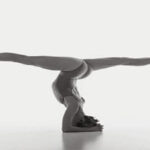Why to Practice Yoga Off The Mat
We all know what yoga on the mat is-it is a yoga style that we devote ourselves to, creating shapes and exercises on the mat and giving our bodies a physical exercise.
But what is yoga under the mat? To me, it is not as simple as the eight limbs of yoga, which is taught by many people.
Yoga is a very personal thing. For everyone, this is a different exercise-some people may like Astonia or strength yoga, and some people may prefer Kundalini or Yin.
Eight limbs of yoga philosophy, originated from Ashtanga(Ashtanga = eight, anga = limbs), are guidelines on how to live a more meaningful and targeted life, and serve as moral compass when we guide this crazy thing called life.
The 8 limbs of yoga are as follows:
1. Yama a guide to the outside world, which teaches us to hold moral standards and have a sense of integrity. Within Amass, it is further subdivided into nonviolence, honesty, no desire and no desire.
2. Niyama: Looking further into the outside world, niyamas teaches us to practice and self-discipline. Subdivided, these are: Socha (cleanliness), Santo Dosha (contentment), Tappas (heat), Swadiya (study of sacred scriptures), and Isvara Pranidhana (submission to God).
3. Asana: we all think it is yoga, which is the action we practice on the mat, connecting breathing and body, consciously and unconsciously, and preparing the mind and body for meditation.
4. Pranayama: translated as breathing, which is the fourth limb. As mentioned above, by observing breathing, the mind and body are brought into the present. Breathing is a good tool, which can help the mind prepare for meditation and enter the back half of limbs.
5. Pratyahara: Here, we start to stay away from the needs of the outside world, instead focus on ourselves and take back our senses, which can easily distract us.
6. Dharana:On the basis of the practice before the sixth limb, we continue to shift the focus inward in Dalana. We have dealt with the interference of the outside world. Now let’s look at the interference of the mind, turn our attention to one thing (such as the energy center in the body, our breath), and prepare for the next stage again.
7. Dhyana:Similar to the Darana above, Channa is meditation, but by going up one flight of stairs. Darana focuses on one thing to lead us into meditation, but uses a single focus to keep our mind still. Zen is to keep your mind still, but you don’t have the concentration and energy needed to focus on one thing. On the contrary, you are just aware, but not nervous or focused.
8. Samadhi: The last of the eight limbs, which is described here as a state of ecstasy, where you surpass yourself and achieve higher enlightenment. This feeling can’t be bought, but experienced. In this feeling, you will get pure happiness, calm, peace and happiness in one minute or even one second, depending on how long your mind allows you to stay in this state. This is definitely not an easy thing!
But with these eight limbs, they lead us into a happier and healthier life. How do they actually lead you to happiness? This is the real yoga practice place. But as mentioned above, yoga is so personal that it is different for everyone.
Yoga connects exercise with meditation, your breath with your body, which separates it from other forms of fitness. You are bringing your mind, body and soul together through your asana, your meditation and your pranayama. All these help you to enter the present, so that you can experience happiness, achievement, peace and connection with yourself together.
Connecting with yourself helps you find out why. Your reason is your driving force, the driving force for you to get through those difficult times, the reason for your existence, and the reason for you to get up when you have no energy in the morning. Yoga helped me find the reason.
Personally, my reason is to be strong and confident on and off the cushion. Keep strong and confident with my postures (arm balance, handstand, handstand) on my cushion, and keep strong and confident in daily life and the challenges it brings (entering COVID-19 and confinement).
In the past three years, I have experienced some challenges of yoga help. I signed my first mortgage and moved into my first home, but I was fired within one month of moving in. I got out of the state of nine to five, changed my whole career and became a yoga teacher (I used to design shoes! ), because of the global epidemic, I lost my job again and had to rent out my apartment and move home with my father. In the middle of all this, my mother suddenly died of lung cancer. My family and friends helped me through the difficulties. But my reason led me through it, and it is still the same, every … every … day.
In the book patanjali Yoga Sutra, yoga is described as “the science of the soul”
For me, this is better than 8 limbs (or at least some of them). Among the eight limbs, some of the most difficult ones are the outer limbs (Yamas and Niyamas). Although it is difficult to practice meditation completely, we all live in a demanding world-demanding our time, attention, love, money, work, health, skills and everything, so that it is difficult to keep ourselves calm, present, happy and cheerful.
Therefore, if yoga is a “science of the soul”, which means that we must take care of our hearts and protect them with the ideas we accept, then my reasons are of great help to this. Whenever we are in trouble, I will return to my reasons, which will lead me into a happier and healthier state. To quote the “Find Your Reason” Foundation, “Yoga can provide you with skills and teach you how to step into the eye of the storm at any time.
So, why did mine give me something? It gave me comfort, strength, confidence and guidance, but it finally brought peace and happiness. When I recall the above stressed sentence, I have a warm feeling, and a smile begins to form-not because life is 100% relaxed or happy. It’s because I’m using the tools in my toolkit to face the storm!
Therefore, I urge you to find your reasons. If you don’t know what this is, it doesn’t matter. Explore it, dance around it, and then connect and cultivate it through your yoga practice.

